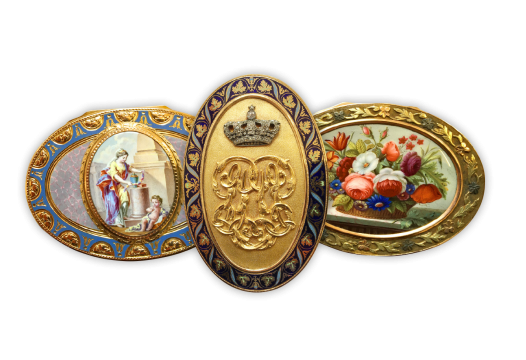Snuff-taking was a real fashion in the 18th and 19th centuries. The more well-off treated themselves to magnificent snuff boxes made out of precious metals as a way of showing their social status. This collection of 41 snuff boxes, donated to the King Baudouin Foundation is a reflection of that.
A magnificent range of snuffboxes
Prior to his death in 2020, Robert Merveille established, through his will, the Germaine Delchambre and Robert Merveille Collection Fund, thanks to which he bequeathed a remarkable collection of snuff boxes to the King Baudouin Foundation. The snuff boxes represent an amazing sample of prestigious artefacts, made at the end of the 18th and early 19th centuries. Composed of various precious metals, the boxes were made using different decorative techniques. The collection bears witness to the fashion of the times, that of snuff-taking, a social event that accompanied numerous rituals, and its importance as a symbol of one’s social status.
The fashion for snuff-taking
In the West, the habit of smoking and snuff-taking originated in the Spanish and Portuguese courts of the 16th century, but it soon spread across the whole of Europe and as far as America. Tobacco was extolled for its health virtues and gradually a real fashion for snuff-taking emerged, initially among the aristocracy and the better off, and later among a wider public. The snuff boxes of the Robert Melville Collection date mostly from the end of the 18th and the beginning of the 19th centuries. During this period, snuff-taking was extremely popular across a large part of Europe.
Luxury snuff boxes: a real status symbol
Little by little, snuff boxes became increasingly luxurious and indeed became a veritable status symbol. Sometimes they matched the owner’s clothes and were transformed into becoming an accessory that reflected the owner’s wealth. Jewellers and silversmiths of the court began to specialise in making these prestigious articles. The majority of pieces in the Delchambre - Merveille Collection were created in Paris, whilst others were made in Hanau and Geneva, which were important production centres for snuff boxes.
The snuff box: an inestimable gift
Offering a precious tobacco box or snuff box as a gift became a widespread habit. Some models, set with diamonds or other precious stones surrounding a portrait, served as diplomatic or military gifts. Snuff boxes decorated with miniature portraits were also given to loved ones as love tokens.
It was frequent at the French court to offer people snuff boxes decorated with a miniature portrait or the royal monogram. This custom also contributed to making the monarch more widely known. The Delchambre - Merveille Collection contains a particularly fine example of such a snuff box, bearing a portrait of Napoleon, which was presented as a gift to Baron Pierre Demadières, the Mayor of Rouen.
The collection also contains two beautiful gold snuff boxes: one with a blue enamel lid encrusted with diamonds and bearing the monogram of King Leopold II of the Belgians with a crown, and the second stamped with the crowned monogram of King Louis-Philippe. The latter was offered as a diplomatic gift on the occasion of the marriage of Leopold I to Louise-Marie d’Orléans.
Where can this collection be seen?
At the request of Robert Merveille, the Hôtel de Groesbeeck-de Croix, the Musée des Arts décoratifs de Namur, will house the collection.
